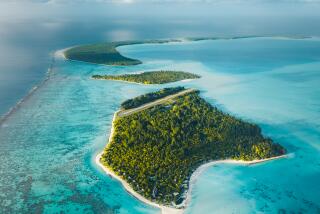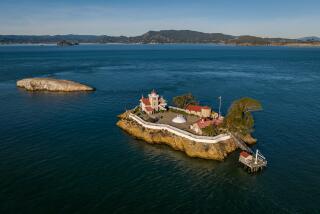A Heady Adventure
- Share via
EASTER ISLAND, Chile — The window-seat passengers pointed frantically. After 2,200 miles and 5 1/2 hours above the Pacific, they had spotted land: cliffs rising to meet gentle hills peppered with volcanic rock.
“Look, moai!” someone blurted. We all strained against our seat belts to see one of the super-size stone statues that make Rapa Nui, as the islanders call their home, an enigma. Why were hundreds of these monuments carved more than half a millennium ago? And who tried to destroy them?
But my wife, JoAnn, and I had not come this far, via Santiago, just to explore the remnants of a toppled civilization. We were here on a mission. Pat, my close friend since junior high, had sent us. His ashes were in a container secured with duct tape and tucked beneath the socks in my duffel bag.
Until I got married a few years ago, Pat and I had traveled together often, mostly through Central America and Mexico. We would just wing it, two bachelors staying in whatever cheap motel we stumbled into and washing down our own cooking--rice, beans, eggs, tortillas--with local beer. And so my cancer-stricken buddy had asked me to take one more trip: “To the South Pacific,” Pat said. “As far out as you can get.”
As our jet banked on its approach, I caught a glimpse of the runway NASA had built in 1986 as an emergency landing strip for the space shuttle. Without it, this remote 46-square-mile dot on the lower rungs of the globe would still be keeping its remarkable trove of ruins largely to itself.
Though its name derives from the day on which a Dutch expedition landed in 1722, and it has been a Chilean territory since 1888, Easter Island really belongs to its Polynesian settlers. They had migrated east in about AD 400, probably from Tonga and Samoa, in large double canoes loaded with supplies.
We emerged from the airport into a hot January breeze smelling of the sea and horses. Herds lope along grassy plains that sprout the occasional clot of trees; few palms survived the over-harvesting during a population swell that also led to bloody clan warfare.
Taxis and tour vans waited at curbside to shuttle bodies and bags the few miles to the island’s only city, Hanga Roa. Our low-slung stucco hotel, the Ota’i, was an easy find in a neighborhood of simple wood-frame houses, a well-stocked market and a post office serving all 3,000 residents. Though Chile views its satellite as a mere extension of the mainland, most islanders are Polynesians who speak Rapa Nui plus enough Spanish and English to work in the predominant trade--tourism.
In honor of my laissez-faire travels with Pat, we arrived unannounced. Fortunately, JoAnn shares my conviction that reservations throw cold water on wanderlust. It was no problem here, especially in January, when temperatures linger in the 90s. (July and August are cooler and wetter.) We dumped the luggage in a clean, spacious room cooled with an electric fan. Hastily applying sunscreen, we walked quickly toward the harbor, about two blocks away. A few surfers bobbed on their boards in the distance.
“There’s one!,” JoAnn said, echoing the excitement heard on the plane. Moments later, we stood beneath a massive rectangular face with thin lips and a peculiar, pensive expression. Over the next four days we would contemplate dozens of faces, each with distinct features: stern moai and sad moai, and even a few sporting borderline smiles.
We wasted no time in renting one of the Suzuki mini-SUVs--the equivalent of a Samurai model--we had seen around town. On wheels, it’s possible to see all the major archeological sites, at least superficially, in a few days. Unfettered by fences or signs, we pulled off the dirt roads and right up to clusters of statues. Though many are buried or only partially exposed in piles of rubble, dozens have been restored by archeologists to good posture. In one spot we discovered campers who had pitched tents in their shadow. If we ever come back, we’ll pack one too.
Various legends and theories surround the moai. One notion is that they represent deified ancestors. Most were carved from tuff,a soft volcanic stone at a single quarry, then moved to the coast and positioned upright on ahu, or stone platforms, facing inland. One exception is the Ahu Akivi ruins, which gaze out to sea. The island’s earliest rock carvings date to about AD 400, and the last to the 1500s. With the largest of these weighing about 82 tons and towering 25 feet, the workers likely used sledges and log rollers to transport them to their final resting places. How, then, did they crown some moai with even more tonnage? Topknots, which are carved from a reddish rock and resemble barrel-shaped hats--or hair, perhaps--decorate a fraction of the moai.
The most arduous hike of several we took during our stay was up the side of the volcanic crater, Rano Raraku, that served as the quarry. Its slope is littered with moai in various stages of production. Some await the carving of eyes and ears, while others need mouths and arms. I tried to imagine the day the stonemasons walked off the job. Why did they drop their tools and leave?
No one knows. But some researchers suspect that the descendants of two waves of settlers clashed in the late 17th century as the population exploded and resources dwindled. Dissension escalated into protracted intertribal wars, and the moai got caught in the middle. Tipping them over was an effective way to insult and anger a rival.
We also explored caves formed by lava flows from the island’s three now-extinct volcanoes. Some contained petroglyphs, and one had painted bird figures on the ceiling.
Arguably the most spectacular sight is in the triangular island’s southwest corner, where the ocean meets the base of the 1,000-foot-high volcano Rano Kau. A mile across, its crater catches the rain that the townspeople tap for drinking water. A man in a rock hut collected our $10 admission, and we walked about 10 minutes along the rim to Orongo. This is the sacred site of the Bird Man cult, which emerged as a sort of political order after the intertribal upheaval. Dimmed by erosion, the 1,785 petroglyphs here, many of which depict bird-like figures, are best seen when the sun is low in the sky, in early morning or late afternoon.
The clan chiefs gathered here to watch their best warriors swim to one of the exposed rocks more than a mile from shore. The first warrior to return with a sooty tern’s egg strapped to his forehead won his chief great status in the community until the next nesting season.
The ritual allowed for the orderly transfer of power from one Bird Man to the next. This had to be among the world’s purest yet least known democracies. The cult continued until European missionaries disapprovingly wagged their fingers.
We ate lunches on the go each day, feasting on pastries, bananas and meats from the grocery store near our hotel. Drinking water, we discovered the hard way, is almost impossible to come by on the shadeless terrain outside of Hanga Roa.
Venturing beyond the hotel dining room, we found a number of small restaurants that were extensions of homes. La Tinita, where we had dinner twice, amounted to a few tables on a front porch. The family cooked and served us excellent dishes featuring fish, chicken, lobster and beef. One of my favorites was listed on the menu, in Spanish and English, as pollo c/ agregado (chicken w/ something).
Other than a patch of sand in Hanga Roa’s man-made harbor--large enough only for outboard fishing boats--the only spots where a body can get wet without being pummeled against sharp rocks are two small beaches on the eastern coast. Getting ashore is so dicey that the early ship captains would often sail by rather than send a supply boat ashore for fresh water and food.
On our second day in town, we tended to the business of Pat’s ashes. Scouting the waterfront for a boat rental, we approached a shirtless man in swimming trunks who stood in the doorway of a small building that flew the red and white international scuba flag. I asked in my so-so Spanish if we might hire him to take us a few miles out to sea. I explained that I carried the “cenizas de mi amigo muerto” and showed him the duct-taped container. He replied in rapid Spanish tinged with a French accent. We all looked confused, so he motioned us toward a small restaurant, where we repeated the request to a young Chilean woman, whom the French expatriate introduced as his wife. “When do you want to go?” she asked.
The four of us got in Henri’s boat, and he pushed off with a pole, slowly navigating around jagged rocks. When we rounded the jetty, he opened the throttle.
“What was the name?” Henri suddenly shouted over the motor.
“Patricio!” I shouted back, giving Pat’s name in Spanish.
Henri stared out to sea for a moment, then let go with a yell that sounded like a battle cry: “Adelante, Patricio!” (Onward, Pat!)
The wind and water heaved. After a few miles our butts were sore, and I signaled Henri to cut the engine. Pat might have wanted me to take him farther, but I peeled off the duct tape and lifted out the ashes, which the funeral home had sealed in a plastic bag. I held the bag over the side and slit it with my pocketknife. The ashes spilled into the sea. “Goodbye, Pat,” my wife said, wiping her eyes.
When we got back to shore, Henri refused to take any money for his trouble.
We would leave with my promise to Pat fulfilled, but also with much of the island unexplored. As we waited to board our flight to Santiago, I reflected on the island’s history of ups and downs. I figured that if the Bird Man cult had survived, much suffering could have been avoided.
“It turned out OK for the islanders,” JoAnn said over the chatter of locals waiting to greet another load of tourists.
“It turned out OK?” I asked.
“The bird,” she said, nodding toward the inbound 767. “The bird has returned.”
GUIDEBOOK
Away From It All on Rapa Nui
Getting there: Lan Chile has nonstop flights from Los Angeles to Santiago, Chile; American and LACSA have direct flights; and Aeromexico, Avianca and United have connecting service (involving plane changes). Round-trip fares begin at $1,225. Lan Chile is the only carrier to Easter Island from Santiago. Round-trip fares begin at $898, but packages that include Easter Island visits will bring the price down; consult a travel agent.
Getting around: Taxis run from the airport to Hanga Roa, the island’s only town. Cabbies charge a fixed rate of $2 within city limits. To explore the ruins, you can rent a car at several locations. At Gerald Rent-a-Car, we found a Suzuki mini-SUV without air-conditioning for $70 a day. We also took a half-day guided tour in a large, new van for $12.50 per person. Almost all the roads are dirt.
Where to stay: The island’s six major hotels are in and around Hanga Roa, priced from about $75 per night to more than $200. We stayed at the very clean, motel-like Ota’i Hotel, near the center of town, for $85 for a double, which included continental breakfast. Our room had hot water but no air-conditioning.
You can try dialing Easter Island direct, but in some areas you’ll have to ask an overseas operator to place a call through an operator in Santiago; the country code is 56, the city code is 32. For the Ota’i, the local telephone number is 100-250. The other major hotels are Hotel Hanga Roa, 100-299; Hotel Hotu Matua, 100-242; Hotel Orongo, 100-294; Hotel Iorana, 100-312; and Rapa Nui Inn, 100-228.
For more information: Lan Chile Airlines, Tour Information Department, 9700 S. Dixie Highway, Miami, FL 33156; tel. (800) CHILE-66, fax (305) 670-9599.
More to Read
Sign up for The Wild
We’ll help you find the best places to hike, bike and run, as well as the perfect silent spots for meditation and yoga.
You may occasionally receive promotional content from the Los Angeles Times.






